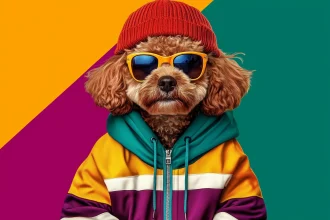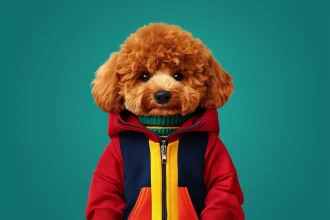Let’s talk about Cavapoo behavior problems – and trust me, after five years of walking these adorable troublemakers, I’ve seen them all. From the anxiety-ridden velcro dogs who can’t let their owners use the bathroom alone, to the serial barkers who’ve memorized the neighborhood squirrel schedule, I’ve dealt with pretty much every quirk and challenge these dogs can throw at us.
Don’t get me wrong – I love Cavapoos. They’re some of my favorite clients. But if you’re struggling with your Cavapoo’s behavior problems, you’re not alone. I spend my days helping owners figure out why their perfect puppy suddenly turned into a furry tornado of issues, and more importantly, how to fix it. This isn’t your typical training manual – it’s real solutions from someone who’s probably cleaned up your dog’s cousin’s mess.
Cavapoo Behavior Problems at a Glance
After walking countless Cavapoos, here’s the real deal: The biggest behavior problems I see are separation anxiety (these pups hate being alone), excessive barking (especially when bored), and destructive chewing (goodbye, favorite shoes). Most of these issues stem from their smart, sensitive nature and strong attachment to their humans.
The good news? Most Cavapoo behavior problems are fixable with the right approach. The trick is catching them early and being consistent with training. I’ve seen the best results when owners focus on two things: giving their Cavapoo enough physical exercise and mental stimulation, and setting clear, consistent boundaries that everyone in the household follows.
Separation Anxiety: The Biggest Challenge
Of all the behavior problems I deal with, separation anxiety in Cavapoos tops the list. These dogs take attachment to a whole new level.
What does separation anxiety actually look like? Well, my client list tells quite the story. There’s Luna, who systematically unraveled an entire couch cushion by cushion – we’re talking stuffing everywhere like it had snowed indoors. Bella somehow managed to chew a perfect oval through her owner’s bedroom door just to get closer to their scent. And then there’s Charlie, who not only howls like he’s auditioning for an opera, but has taught the other dogs in the building to join his choir. His owner got so many complaint letters she started bringing baked goods to the neighbors’ doors as preemptive apologies.
Some Cavapoos get so worked up they can’t even eat or drink while their owners are gone – like my client’s pup Ollie, who won’t touch his breakfast until his mom gets home at 6 PM.
The trick with separation anxiety isn’t to tough it out – trust me, I’ve seen that approach backfire spectacularly. Instead, it’s about baby steps. One of my most successful clients started by literally just walking to their mailbox and back, gradually building up to longer absences. They also stopped making a big deal about coming and going, which helped their Cavapoo realize that departures weren’t the end of the world.
Here’s what actually works: Start by giving your Cavapoo a safe space – a crate or cozy corner that’s just theirs. Leave them with something that smells like you (my client Sarah rotates through her old t-shirts), and give them special toys they only get when alone. And please, for everyone’s sake, tire them out before leaving them alone. A tired Cavapoo is much more likely to nap than panic.
The Barking Situation
Let’s be honest: Cavapoos can be chatty. Really chatty. I’ve got one on my roster who I swear speaks in full sentences. But there’s a difference between normal Cavapoo “commentary” and problem barking.
Most Cavapoos bark for specific reasons. My client Luna used to bark at everything that moved outside her window. Turns out, she was bored and had made a game of it. Once we added a midday walk and moved her bed away from the window, the barking dropped dramatically. Another client, Charlie, would bark non-stop when left alone – classic separation anxiety barking that needed a whole different approach.
What works for excessive barking depends on why they’re doing it. For attention-seeking barkers, ignoring the behavior and rewarding quiet moments does wonders. For alert barkers, managing their environment makes a huge difference – like closing curtains during peak squirrel hours.
The key is consistency. If you tell them “quiet” but then give in and pay attention to their barking anyway, you’re just teaching them to bark longer next time. Trust me, I’ve seen this play out with dozens of dogs – the ones who improve are the ones whose owners stick to their guns.
When Good Dogs Go Destructive
If there’s one thing that breaks my heart, it’s getting a panicked call from an owner about their Cavapoo’s latest demolition project. Just last week, my client’s pup Tommy turned a $200 throw pillow into what looked like confetti – and he’d never shown destructive behavior before.
Here’s what most people don’t realize: Destructive behavior usually isn’t about the stuff being destroyed. Take my client’s Cavapoo, Penny. She only chewed baseboards when her owner worked late. Another client, Oscar, exclusively destroyed things that smelled like his teenager who’d just left for college. These dogs aren’t being spiteful – they’re trying to cope with anxiety or boredom.
From what I’ve seen on my daily walks, destructive behavior in Cavapoos usually falls into three categories. There’s the anxiety chewers, the bored destroyers and the “I’m a puppy and everything goes in my mouth” crew. Each needs a different approach.
For anxiety chewers, you’ve got to address the underlying stress first. One of my clients had great success giving their dog a food puzzle toy whenever they had to take work calls – turns out their pup was stressed by hearing their voice but not being able to reach them. Simple solution, happy dog, surviving furniture.
For the bored bunch, it’s all about prevention and redirection. I tell my clients to think like a toddler-proofer: if you don’t want it chewed, don’t make it accessible. But more importantly, give them something better to do. A frozen Kong toy works wonders – I’ve got one client who preps five at a time and rotates them throughout the week.
Leash Drama: Pulling, Lunging, and Street Snacks
As someone who walks Cavapoos professionally, I’ve got to talk about leash behavior. These little guys can be perfect angels at home but turn into sled dogs the moment a leash clicks on.
The most common leash problems I see with Cavapoos are pulling (they’re stronger than they look), sudden lunging (usually at exciting things like birds or other dogs), and what I call “street sweeping” – trying to eat everything they find on walks.
Here’s what I’ve learned works for leash training: First, forget about those retractable leashes. I know they seem convenient, but they’re basically teaching your dog that pulling gets them what they want. A regular 6-foot leash gives you much better control. My client Sarah switched from a retractable to a standard leash, and her Cavapoo’s pulling improved within a week.
For pullers, the “stop and go” method has worked wonders for my clients. It’s simple but requires patience: when your dog pulls, you stop. Only move forward when the leash is loose. Yes, your short walk might take forever at first (I once spent 15 minutes going half a block with a particularly determined puller), but most Cavapoos catch on pretty quickly.
The lunging issue often comes down to excitement or anxiety. I had one client whose Cavapoo would lunge at every dog they saw – turns out she just wanted to say hi. We worked on the “look at me” command with high-value treats, and now she can walk past other dogs without turning into a furry pinball.
As for the street snackers – this one’s about management and training. I teach my clients to use the “leave it” command (starting with treats at home, then graduating to less exciting stuff on walks). But I also tell them to stay alert – these clever pups can spot a discarded chicken bone from impressive distances.
Training Solutions That Actually Work
After years of helping owners train their Cavapoos, I’ve learned one crucial thing: these dogs are smart enough to train you if you’re not careful.
The good news is that their intelligence makes them highly trainable – when you do it right. The trick is understanding how Cavapoos think. They’re sensitive souls who shut down with harsh corrections but absolutely bloom with positive reinforcement. I’ve watched tough cases turn around completely once their owners switched from scolding to rewarding good behavior.
Here’s what works in the real world: Short, upbeat training sessions win over marathon ones every time. My most successful clients do three five-minute sessions a day rather than one long one. They also keep it fun – their Cavapoos genuinely get excited when it’s training time because it means attention and treats.
A game-changer for many of my clients has been “capturing” good behavior. Instead of always telling their dog what not to do, they watch for moments when their pup makes good choices and reward those. One of my clients completely solved their jumping problem just by keeping treats handy and rewarding “four on the floor” whenever someone came to the door.
The biggest training mistake I see? Inconsistency. Cavapoos are masters at spotting loopholes. If Mom says “no couch” but Dad allows sofa snuggles, guess what? Your pup will learn that the rules are optional. I’ve got one client whose Cavapoo literally checks to see who’s home before deciding whether to follow commands. Too smart for their own good, I tell you.
Exercise Needs Beyond the Basics
Here’s something that might surprise you: most Cavapoo behavior problems I deal with get significantly better with the right amount of exercise. Notice I said “right amount” – not too little, not too much.
I’ll never forget my client’s Cavapoo who was labeled “hyperactive” and “untrainable.” Turns out, those two quick potty breaks a day weren’t cutting it. Once we added a proper midday walk with plenty of sniffing time (yes, sniffing counts as exercise for these guys), she transformed into a different dog.
But here’s the thing about Cavapoos – they’re all individuals. I’ve got one on my roster who needs an hour of active walking to settle down, while another is done after 20 minutes of leisurely strolling. The trick is reading your dog’s signals. Getting the zoomies every evening? Probably needs more exercise. Dragging their feet halfway through a walk? You might be overdoing it.
Mental Stimulation
Physical exercise is only half the battle – these dogs need their minds worked too. One of my most well-behaved clients, a Cavapoo named Cooper, gets less physical exercise than most but does food puzzles, training games, and scent work every day. His owner swears it keeps him out of trouble better than long walks alone.
Some real-world mental workout ideas that have worked for my clients:
- Scatter feeding (throwing kibble in the grass for them to find)
- Food puzzle toys (start easy and work up to harder ones)
- Teaching new tricks (one client taught their pup to bring them specific toys by name)
- “Find it” games with treats or toys
Just last week, I had a client tell me their destructive Cavapoo completely stopped chewing furniture once they started hiding treats around the house before leaving for work. Turns out, a tired mind makes for a better-behaved dog.
When to Call in the Pros
Look, I’m the first to encourage owners to work through behavior problems, but sometimes you need backup. After walking hundreds of dogs, I’ve learned there are certain situations where professional help isn’t just helpful – it’s necessary.
Consider getting expert help if: Your Cavapoo’s behavior is getting worse despite your best efforts. There’s any aggression, even if it seems minor (better to address it early) You’re feeling overwhelmed or frustrated (no shame in this – dog training is hard!) Multiple approaches haven’t worked (sometimes you need fresh eyes on the situation)
I had a client who spent months trying to solve their Cavapoo’s resource guarding on their own. One session with a professional trainer gave them the tools they needed, and within weeks, the problem was manageable. Sometimes that outside perspective makes all the difference.
Conclusion
Here’s what I tell all my Cavapoo clients: yes, these dogs can have their challenges, but they’re also some of the most rewarding pets I work with. Most behavior problems come down to three things: meeting their physical and mental needs, being consistent with training, and understanding what makes them tick.
Remember, every Cavapoo is unique. What works for your neighbor’s perfect pup might not work for yours, and that’s okay. Take it from someone who spends their days with these lovable troublemakers – with patience, understanding, and the right approach, most behavior problems can be solved.
And if you’re struggling? Don’t beat yourself up about it. Even the most experienced dog owners need help sometimes. What matters is that you’re trying to understand and help your furry friend. After all, that’s why they love us – we’re their people, quirks and all.
FAQs
With early intervention and consistency in training, most Cavapoo behavioral problems show improvement within 4-8 weeks. However, issues like separation anxiety or excessive barking may take 3-6 months of dedicated training. Success depends on identifying root causes, using positive reinforcement, and maintaining routine.
Address food aggression by feeding your Cavapoo in a quiet area, using positive reinforcement to reward calm behavior. Start by standing away from their bowl, gradually moving closer while dropping high-value treats. Never punish or remove food, as this worsens aggression. Consult a professional for severe cases.
Begin socialization gradually in controlled environments, using positive reinforcement to build confidence. Start with calm environments and friendly, vaccinated dogs. Keep initial interactions brief, reward calm behavior, and watch for stress signals. Build up duration as your Cavapoo gains confidence.
Address adult potty training issues by establishing a strict schedule, ruling out health issues with a vet check, and using positive reinforcement for correct elimination. Clean accidents thoroughly with enzymatic cleaner, maintain consistency in training, and consider anxiety as a potential cause.













